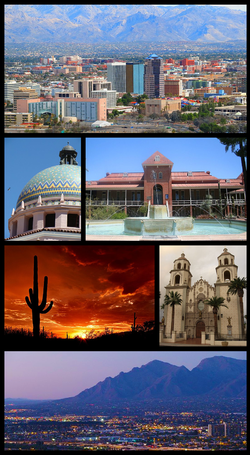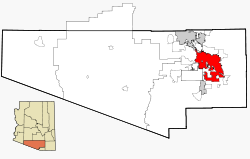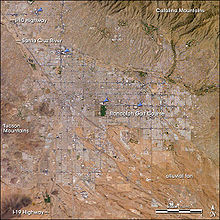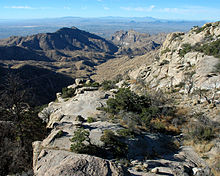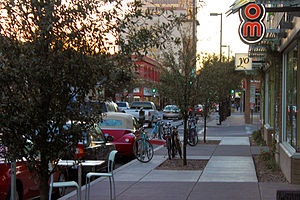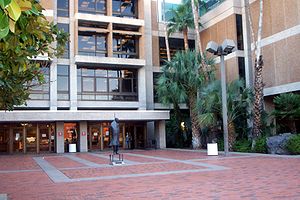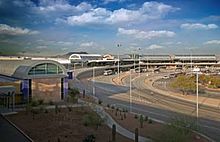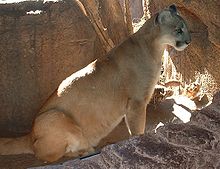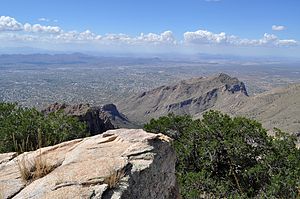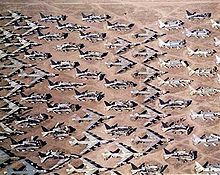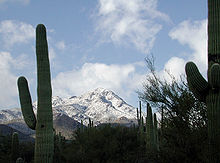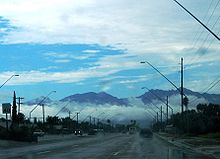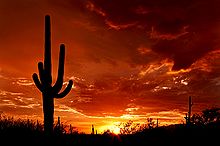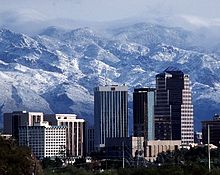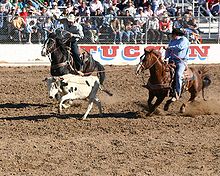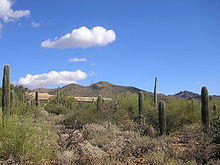- Tucson, Arizona
-
"Tucson" redirects here. For other uses, see Tucson (disambiguation).
Tucson — City — From upper left: Downtown Tucson Skyline, Pima County Courthouse, Old Main, University of Arizona, Saguaro National Park, St. Augustine Cathedral, Santa Catalina Mountains Nickname(s): The Old Pueblo, Optics Valley Location in Pima County and the state of Arizona Location in the United States Coordinates: 32°13′18″N 110°55′35″W / 32.22167°N 110.92639°WCoordinates: 32°13′18″N 110°55′35″W / 32.22167°N 110.92639°W Country United States County Pima Government – Type Council-manager government – Mayor Bob Walkup Area – City 195.1 sq mi (505.3 km2) – Land 194.7 sq mi (504.2 km2) – Water 0.4 sq mi (1.1 km2) Elevation 2,389 ft (728 m) Population (2010) – City 520,116 – Density 2,793.6/sq mi (1,078.8/km2) – Urban 720,425 – Metro 1,020,200 – Demonym Tucsonan Time zone MST (UTC-7) Area code 520 FIPS code 04-77000 Website www.tucsonaz.gov 1 Urban = 2000 Census Tucson (
 /ˈtuːsɒn/ too-son) is a city in and the county seat of Pima County, Arizona, United States. The city is [1] located 118 miles (188 km) southeast of Phoenix and 60 miles (98 km) north of the U.S.-Mexico border. The 2010 United States Census puts the city's population at 520,116 [2] with a metropolitan area population at 1,020,200. In 2009, Tucson ranked as the 32nd largest city and 52nd largest metropolitan area in the United States. A major city in the Arizona Sun Corridor, Tucson is the largest city in southern Arizona, the second largest in the state after Phoenix. It is also the largest city in the area of the Gadsden Purchase. Tucson is home to the University of Arizona. Roughly 150 Tucson companies are involved in the design and manufacture of optics and optoelectronics systems, earning Tucson the nickname Optics Valley.
/ˈtuːsɒn/ too-son) is a city in and the county seat of Pima County, Arizona, United States. The city is [1] located 118 miles (188 km) southeast of Phoenix and 60 miles (98 km) north of the U.S.-Mexico border. The 2010 United States Census puts the city's population at 520,116 [2] with a metropolitan area population at 1,020,200. In 2009, Tucson ranked as the 32nd largest city and 52nd largest metropolitan area in the United States. A major city in the Arizona Sun Corridor, Tucson is the largest city in southern Arizona, the second largest in the state after Phoenix. It is also the largest city in the area of the Gadsden Purchase. Tucson is home to the University of Arizona. Roughly 150 Tucson companies are involved in the design and manufacture of optics and optoelectronics systems, earning Tucson the nickname Optics Valley.Major incorporated suburbs of Tucson include Oro Valley and Marana northwest of the city, Sahuarita south of the city, and South Tucson in an enclave south of downtown. Communities in the vicinity of Tucson (some within or overlapping the city limits) include Casas Adobes, Catalina Foothills, Flowing Wells, Tanque Verde, Tortilita, New Pascua, Sahuarita and Vail. Towns outside the Tucson metro area include Benson to the southeast, Catalina and Oracle to the north, and Green Valley to the south.
The English name Tucson derives from the Spanish name of the city, Tucsón [tukˈson], which was borrowed from the O'odham name Cuk Ṣon [tʃʊk ʂɔːn], meaning "(at the) base of the black [hill]", a reference to an adjacent volcanic mountain. Tucson is sometimes referred to as "The Old Pueblo".
History
Main article: History of Tucson, ArizonaTucson was probably first visited by Paleo-Indians, known to have been in southern Arizona by about 12,000 years ago. Recent archaeological excavations near the Santa Cruz River have located a village site dating from 4,000 years ago.[citation needed] The floodplain of the Santa Cruz River was extensively farmed during the Early Agricultural period, circa 1200 BC to AD 150. These people constructed irrigation canals and grew corn, beans, and other crops while gathering wild plants and hunting animals. The Early Ceramic period occupation of Tucson saw the first extensive use of pottery vessels for cooking and storage. The groups designated by archaeologists as the Hohokam lived in the area from AD 600 to 1450 and are known for their vast irrigation canal systems as well as their red-on-brown pottery.
Jesuit missionary Eusebio Francisco Kino visited the Santa Cruz River valley in 1692, and founded the Mission San Xavier del Bac in 1700 about 7 miles (12 km) upstream from the site of the settlement of Tucson. A separate Convento settlement was founded downstream along the then flowing Santa Cruz River, near the base of what is now "A" mountain. The Spanish subsequently established a walled fortress, Presidio San Agustín del Tucsón, on August 20, 1775 (near the present downtown Pima County Courthouse). During the Spanish period of the presidio, attacks such as the Second Battle of Tucson were repeatedly mounted by Apaches. Eventually the town came to be called "Tucson" and became a part of Mexico after Mexico gained independence from Spain in 1821. Tucson was captured by the Mormon Battalion during the Mexican-American War, but later returned to Mexican control. Tucson was not included in the Mexican Cession – it was following the Gadsden Purchase in 1853 that Tucson became a part of the United States of America, although the American military did not formally take over control of the community until March 1856. In 1857 Tucson became a stage station on the San Antonio-San Diego Mail Line and in 1858 became 3rd division headquarters of the Butterfield Overland Mail until the line shut down in March 1861. The Overland Mail Corporation attempted to continue operations, however following the Bascom Affair, devastating Apache attacks on the stations and coaches ended operations in August 1861.[citation needed]
From August 1861, until mid-1862, Tucson was the western capital of the Confederate Arizona Territory, the eastern capital being Mesilla. In 1862 the California Column drove the Confederate forces out of Arizona. Tucson and all of what is now Arizona was part of New Mexico Territory until 1863, when it became part of the new Arizona Territory. From 1867 to 1877, Tucson was the capital of Arizona Territory. From 1877 to 1878, the Tucson area suffered from a rash of stagecoach robberies. Most notably, however, were the two robberies committed by masked road-agent William Whitney Brazelton. [3] Brazelton held-up two stages in the summer of 1878 near Point of Mountain Station approximately seventeen miles northwest of Tucson. John Clum of Tombstone fame was one of the passengers held-up and Brazelton would eventually be tracked down and killed on Monday August 19, 1878 in a mesquite bosque along the Santa Cruz River three miles south of Tucson by Pima County Sheriff Charles A. Shibell and his citizen's posse. Brazelton had been suspected of highway robbery not only in the Tucson area, but also in the Prescott region and Silver City, New Mexico area as well. Brazelton's crimes prompted John J. Valentine, Sr. of Wells, Fargo & Co. to send special agent and future Pima County sheriff Bob Paul to investigate. [3] Fort Lowell, then east of Tucson, was established to help protect settlers from Apache attacks. In 1882, Frank Stilwell was implicated in the murder of Morgan Earp by Cowboy Pete Spence's wife, Marietta, at the coroner's inquest on Morgan Earp's shooting. The coroner's jury concluded that Spence, Stilwell, Frederick Bode, and Florentino "Indian Charlie" Cruz were the prime suspects in the assassination of Morgan Earp.[4] :250 Deputy U.S. Marshal Wyatt Earp gathered a few friends he could trust and accompanied Virgil Earp and his family as they traveled to Benson for a train ride to California. They found Stilwell lying in wait for Virgil in the Tucson train station and killed him on the train tracks.[5] After killing Stilwell, Wyatt deputized others and rode on a vendetta, killing three more Cowboys over the next few days before leaving the state.
In 1885, the University of Arizona, was founded as a land-grant college on over-grazed ranch land between Tucson and Fort Lowell.
By 1900, 7,531 people lived in the city. The population increased gradually to 13,913 in 1910. At about this time, the U.S. Veterans Administration had begun construction on the present Veterans Hospital. Many veterans who had been gassed in World War I and were in need of respiratory therapy began coming to Tucson after the war, due to the clean dry air. Over the following years the city continued to grow, with the population increasing to 20,292 in 1920 and 36,818 in 1940. In 2006 the population of Pima County, in which Tucson is located, passed one million while the City of Tucson's population was 535,000.
In 1912, when Arizona statehood became reality, the total number of different flags that had flown over Tucson now numbered five, American, Spanish, Mexican, Confederate, and the State of Arizona. [6]
During the territorial and early statehood periods, Tucson was Arizona's largest city and commercial center, while Phoenix was the seat of state government (beginning in 1889) and agriculture. The establishment of Tucson Municipal Airport increased its prominence. Between 1910 and 1920 Phoenix surpassed Tucson in population, and has continued to outpace Tucson in growth. In recent years, both Tucson and Phoenix have experienced among the highest growth rates in the United States.
Geography
According to the United States Census Bureau, Tucson has a total area of 195.1 square miles (505 km2), of which 194.7 square miles (504 km2) is land and 0.4 square miles (1.0 km2) (0.22%) is water.
The Tucson skyline is dominated by mountains in every direction. Close in to the city are the Santa Catalina Mountains to the north, the Rincon Mountains to the east, and the Tucson Mountains, closest of all, on the west side. Farther from the city proper, but still commanding the southern sky are the Santa Rita Mountains. And farthest of all, generally not visible from most of the city, are the Tortolita Mountain Range to the northwest. The highest point in the area is Mount Wrightson found in the Santa Rita Mountains at 9,453 feet (2,881 m) above sea level. Mount Lemmon is popularly thought to be higher, looming much closer over the city, but misses Mt. Wrightson's peak by 297 feet (91 m).
The city's elevation is 2,643 ft (728 m) above sea level (as measured at the Tucson International Airport).[7] Tucson is situated on an alluvial plain in the Sonoran desert, surrounded by five minor ranges of mountains: the Santa Catalina Mountains and the Tortolita Mountains to the north, the Santa Rita Mountains to the south, the Rincon Mountains to the east, and the Tucson Mountains to the west. The high point of the Santa Catalina Mountains is 9,157-foot (2,791 m) Mount Lemmon, the southernmost ski destination in the continental U.S., while the Tucson Mountains include 4,687-foot (1,429 m) Wasson Peak. The highest point in the area is Mount Wrightson, found in the Santa Rita Mountains at 9,453 feet (2,881 m) above sea level.
Tucson is a city in and the county seat of Pima County, Arizona, United States. The city is located 118 miles (188 km) southeast of Phoenix and 60 miles (98 km) north of the United States - Mexico border. The 2010 United States Census puts the city's population at 520,116 with a metropolitan area population at 1,020,200. In 2009, Tucson ranked as the 32nd largest city and 52nd largest metropolitan area in the United States. A major city in the Arizona Sun Corridor, Tucson is the largest city in southern Arizona, the second largest in the state after Phoenix. It is also the largest city in the area of the Gadsden Purchase.
The city is located on the Santa Cruz River, formerly a perennial river but now a dry river bed for much of the year that floods during significant seasonal rains.
Interstate 10, which runs southeast to northwest through town, connects Tucson to Phoenix to the northwest on the way to its western terminus in Santa Monica, California, and to Las Cruces, New Mexico and El Paso, Texas toward its eastern terminus in Jacksonville, Florida. I-19 runs south from Tucson toward Nogales and the U.S.-Mexico border. I-19 is the only Interstate highway that uses "kilometer posts" instead of "mileposts", although the speed limits are marked in miles per hour instead of kilometers per hour.
Downtown and Central Tucson
Similar to many other cities in the Western U.S., Tucson was developed on a grid plan starting in the late 19th century, with the city center at Stone Avenue and Broadway Boulevard. While this intersection was initially near the geographic center of Tucson, that center has shifted as the city has expanded far to the east, development to the west being effectively blocked by the Tucson Mountains. An expansive city covering substantial area, Tucson has many distinct neighborhoods.
Tucson's earliest neighborhoods, some of which are now covered by the Tucson Convention Center, or TCC, include:
- El Presidio,[8] Tucson's oldest neighborhood
- Barrio Histórico,[9] also known as Barrio Libre
- Armory Park, directly south of downtown
- Barrio Anita,[10] named for an early settler and located between Granada Avenue and Interstate 10
- Barrio Tiburón, now known as the Fourth Avenue arts district – designated in territorial times as a red-light district
- Barrio El Jardín, named for an early recreational site, Levin's Gardens
- Barrio El Hoyo, named for a lake that was part of the gardens. Before the TCC was built, El Hoyo (Spanish for pit or hole) referred to this part of the city, which was inhabited mainly by Mexican-American citizens and Mexican immigrants.
Other historical neighborhoods near downtown include:
- Feldman's, named for an early resident photographer (with the streets "Helen" and "Mabel" named for his daughters)[11]
- Menlo Park, situated west of downtown, adjacent to "A Mountain" more correctly called Sentinel Peak
- Iron Horse, east of Fourth Avenue and north of the railroad tracks, named for its proximity
- West University, located between the University of Arizona and downtown
- Pie Allen, located west and south of the university near Tucson High School and named for a local entrepreneur and early mayor of Tucson
- Sam Hughes, located east of the University of Arizona and named after an instigator/hero of the Camp Grant Massacre
At the end of the first decade of the 21st century, downtown Tucson is undergoing a revitalization effort by city planners and the business community. The primary project is Rio Nuevo, a large retail and community center that has been stalled in planning for more than ten years.[12][13] Downtown is generally regarded as the area bordered by 17th Street to the south, I-10 to the west, and 6th Street to the north, and Toole Avenue and the Union Pacific (formerly Southern Pacific) railroad tracks, site of the historic train depot[14] and "Locomotive #1673", built in 1900. Downtown is divided into the Presidio District, the Barrio Viejo, and the Congress Street Arts and Entertainment District.[15] Some authorities include the 4th Avenue shopping district, which is set just northeast of the rest of downtown and connected by an underpass beneath the UPRR tracks.
Attractions downtown include the Hotel Congress designed in 1919, the Art Deco Fox Theater designed in 1929, the Rialto Theatre opened in 1920, and St. Augustine Cathedral completed in 1896.[16] Included on the National Register of Historic Places is the old Pima County Courthouse, designed by Roy W. Place in 1928.[17] The El Charro Café, Tucson's oldest restaurant, also operates its main location downtown.[18]
As one of the oldest parts of town, Central Tucson is anchored by the Broadway Village shopping center designed by local architect Josias Joesler at the intersection of Broadway Boulevard and Country Club Road. The 4th Avenue Shopping District between downtown and the University and the Lost Barrio just East of downtown also have many unique and popular stores. Local retail business in Central Tucson is densely concentrated along Fourth Avenue and the Main Gate Square on University Boulevard near the UA campus. The El Con Mall is also located in the eastern part of midtown.
The University of Arizona, chartered in 1885, is located in midtown and includes Arizona Stadium and McKale Center. Historic Tucson High School (designed by Roy Place in 1924) featured in the 1987 film Can't Buy Me Love, the Arizona Inn (built in 1930), and the Tucson Botanic Gardens are also located in Central Tucson.
Tucson's largest park, Reid Park is located in midtown and includes Reid Park Zoo and Hi Corbett Field. Speedway Boulevard, a major east-west arterial road in central Tucson, was named the "ugliest street in America" by Life magazine in the early 1970s, quoting Tucson Mayor James Corbett. Despite this, Speedway Boulevard was awarded "Street of the Year" by Arizona Highways in the late 1990s.
Central Tucson is bicycle-friendly. To the east of the University of Arizona, Third Street is bike-only except for local traffic and passes by the historic homes of the Sam Hughes neighborhood. To the west, E. University Boulevard leads to the Fourth Avenue Shopping District. To the North, N. Mountain Avenue has a full bike-only lane for half of the 3.5 miles (5.6 km) to the Rillito River Park bike and walk multi-use path. To the south, N. Highland Avenue leads to the Barraza-Aviation Parkway bicycle path.
Southern Tucson
South Tucson is actually the name of an independent, incorporated town of one square mile, completely surrounded by the city of Tucson, sitting just south of downtown. South Tucson has a colorful, dynamic history. It was first incorporated in 1936, and later reincorporated in 1940. The population consists of about 83% Mexican-American and 10% Native American. South Tucson is widely known for its many Mexican restaurants and the architectural styles which including bright outdoor murals many of which have been painted over due to city policy.[19][20][21]
The South side of the city of Tucson is generally considered to be the area of approximately 25 square miles (65 square kilometers) north of Los Reales Road, south of 22nd Street, east of I-19, west of Davis Monthan Air Force Base and southwest of Aviation Parkway. Much of Tucson's Mexican-American population live on the south side. The Tucson International Airport and Tucson Electric Park are also located here.[citation needed]
Western Tucson
A combination of urban and suburban development, the West Side is generally defined as the area west of I-10. Western Tucson encompasses the banks of the Santa Cruz River and the foothills of the Tucson Mountains, and includes the International Wildlife Museum, Sentinel Peak and the Marriott Starr Pass Resort & Spa. Moving past the Tucson Mountains you are in the area commonly referred to as "west of" Tucson. A large undulating plain extending into the Altar Valley, rural residential development predominates, but here you will also find major attractions including Saguaro National Park West, the Arizona-Sonora Desert Museum, and the Old Tucson Studios movie set/theme park.
On Sentinel Peak (also known as "'A' Mountain"), just west of downtown, there is a giant "A" in honor of the University of Arizona. Starting in about 1910, a yearly tradition developed for freshmen to whitewash the "A", which was visible for miles. However, at the beginning of the Iraq War, anti-war activists painted it black.[citation needed] This was followed by a paint scuffle where the "A" was painted various colors until the city council intervened. It is now red, white and blue except when it is white or another color decided by a biennial election. Because of the three-color paint scheme often used, the shape of the A can be vague and indistinguishable from the rest of the peak. The top of Sentinel Peak, which is accessible by road, offers an outstanding scenic view of the city looking eastward. A parking lot located near the summit of Sentinel Peak was formerly a popular place to watch sunsets or view the city lights at night.
Northern Tucson
North Tucson includes the urban neighborhoods of Amphitheater and Flowing Wells. Usually considered the area north of Fort Lowell Road, north Tucson includes some of Tucson's primary commercial zones (Tucson Mall and the Oracle Road Corridor). Many of the city's most upscale boutiques, restaurants, and art galleries are also located on the north side including St. Philip's Plaza. The Plaza is directly adjacent to the historic St. Philip's in the Hills Episcopal Church (built in 1936).
Also on the north side is the suburban community of Catalina Foothills, located in the foothills of the Santa Catalina Mountains just north of the city limits. This community includes among the area's most expensive homes, sometimes multi-million dollar estates. The Foothills area is generally defined as north of River Road, east of Oracle Road, and west of Sabino Creek. Some of the Tucson area's major resorts are located in the Catalina Foothills, including the Hacienda Del Sol, Westin La Paloma Resort, Loews Ventana Canyon Resort and Canyon Ranch Resort. La Encantada, an upscale outdoor shopping mall, is also in the Foothills.
The DeGrazia Gallery of the Sun near the intersection of Swan Road and Skyline Drive. Built by artist Ted DeGrazia starting in 1951, the 10-acre (40,000 m2) property is listed on the National Register of Historic Places and features an eclectic chapel, an art gallery and a free museum.
The expansive area northwest of the city limits is diverse, ranging from the rural communities of Catalina and parts of the town of Marana, the small suburb of Picture Rocks, the affluent town of Oro Valley in the western foothills of the Santa Catalina Mountains, and residential areas in the northeastern foothills of the Tucson Mountains. Continental Ranch (Marana), Dove Mountain (Marana), and Rancho Vistoso (Oro Valley) are all masterplanned communities located in the Northwest, where thousands of residents live.
The community of Casas Adobes is also on the Northwest Side, with the distinction of being Tucson's first suburb, established in the late 1940s. Casas Adobes is centered on the historic Casas Adobes Plaza (built in 1948). Casas Adobes is also home to Tohono Chul Park (a nature preserve) near the intersection of North Oracle Road and West Ina Road. The attempted assassination of Representative Gabrielle Giffords, and the murders of chief judge for the U.S. District Court for Arizona, John Roll and five other people on January 8, 2011 occurred at the La Toscana Village in Casas Adobes. The Foothills Mall is also located on the northwest side in Casas Adobes.
Many of the Tucson area's golf courses and resorts are located in this area, including the Hilton El Conquistador Golf & Tennis Resort in Oro Valley, the Omni Tucson National Resort & Spa, and Westward Look Resort. The Ritz Carlton at Dove Mountain, the second Ritz Carlton Resort in Arizona, which also includes a golf course, opened in the foothills of the Tortolita Mountains in northeast Marana in 2009. Catalina State Park and Tortolita Mountain Park are also located in the Northwest area.
Eastern Tucson
East Tucson is relatively new compared to other parts of the city, developed between the 1950s and the 1970s,[citation needed] with developments such as Desert Palms Park. It is generally classified as the area of the city east of Swan Road, with above-average real estate values relative to the rest of the city. The area includes urban and suburban development near the Rincon Mountains. East Tucson includes Saguaro National Park East. Tucson's "Restaurant Row" is also located on the east side, along with a significant corporate and financial presence. Restaurant Row is sandwiched by three of Tucson's storied Neighborhoods: Harold Bell Wright Estates, named after the famous author's ranch which occupied some of that area prior to the depression; the Tucson Country Club, and the Dorado Country Club. Tucson's largest office building is 5151 East Broadway in east Tucson, completed in 1975. Park Place, a recently renovated shopping center, is also located there.
Near the intersection of Craycroft and Ft. Lowell Road are the remnants of the Historic Fort Lowell. This area has become one of Tucson's iconic neighborhoods. The Fort abandoned at the end of the 19th century was rediscovered by a trio of artists in the 1930s.[citation needed] The Bolsius family Pete, Nan and Charles Bolsius purchased and renovated surviving adobe buildings of the Fort – transforming them into spectacular artistic southwestern architectural examples. Their woodwork, plaster treatment and sense of proportion drew on their Dutch heritage and New Mexican experience.[citation needed] This rural pocket in the middle of the city is listed on the National register of Historic Places. Each year in February the neighborhood celebrates its history in the City Landmark it owns and restored the San Pedro Chapel.[citation needed]
Situated between the Santa Catalina Mountains and the Rincon Mountains near Redington Pass northeast of the city limits is the affluent community of Tanque Verde. The Arizona National Golf Club, Forty-Niners Country Club, and the historic Tanque Verde Guest Ranch are also in northeast Tucson.
Southeast Tucson continues to experience rapid residential development. The area includes Davis-Monthan Air Force Base. The area is considered to be south of Golf Links Road. It is the home of Santa Rita High School, Chuck Ford Park (Lakeside Park), Lakeside Lake, Lincoln Park (upper and lower), The Lakecrest Neighborhoods, and Pima Community College East Campus. The Atterbury Wash with its access to excellent bird watching is also located in the Southeast Tucson area. The suburban community of Rita Ranch houses many of the military families from Davis-Monthan, and is near the southeastern-most expansion of the current city limits. Close by Rita Ranch and also within the city limits lies Civano, a planned development meant to showcase ecologically sound building practices and lifestyles. While the houses certainly meet that goal, other aspects of the development have been less successful.[citation needed]
Mount Lemmon
Mount Lemmon, the highest peak of the Santa Catalina Mountains, reaches an elevation of 9,157 feet (2,791 m) above sea level. The mountain is named after 19th Century botanist Sara Lemmon. She was the first documented European to ascend to the peak and was purportedly guided by local Tohono O'odham up through Babad Do'ag (the O'odham name for the Santa Catalina Mountains).[22] Lemmon botanized extensively along the way, including collecting the plant Tagetes lemmoni which is now called the Mount Lemmon marigold.
Near the top of Mt. Lemmon is the town of Summerhaven. This is one of Tucson's biggest vacation spots. While it can be hiked, most people use Catalina Highway, which stretches 25 miles (40 km). In Summerhaven, visitors will find log houses, shops, and a rather large gift shop. Also, there is another road that leads to Mount Lemmon, where one will find a ski area.
Mt. Lemmon Sky Center, which is located at a Steward Observatory site known as 'Sky Island', sits 9,152 feet (2,790 m) in altitude on the summit of Mt. Lemmon. As one of the Southwestern United States's 27 unique Sky Islands,[23] this science learning facility is open to the public.[24]
Climate and environmental issues
Tucson has hot summers and temperate winters. However, Tucson is almost always cooler and wetter than Phoenix because of its higher elevation.
Tucson has a desert climate (Köppen Bwh), with two major seasons, summer and winter; plus three minor seasons: fall, spring, and the monsoon. Though Tucson receives more precipitation than most other locations with desert climates, it still qualifies due to its high evapotranspiration in spite of receiving 11.8 inches (299.7 mm) of precipitation per year; in other words, it experiences a high net loss of water.[25] A similar scenario is seen in Alice Springs, Australia which averages 11 inches (279.4 mm) a year, but has a desert climate.
The most obvious difference of climate from most other inhabited regions is the extremely hot and sunny climate. This difference is a major contributing factor to a rate of skin cancer that is at least 3 times higher than in more northerly regions.[26] Media reports heat related deaths increasing among illegal immigrants in and around Tucson. Heatstroke related deaths have been recorded since 1999 in the Pima County Area.[27]
Summer is characterized by daytime temperatures that exceed 100 °F (37 °C) and overnight temperatures between 66 °F (19 °C) and 85 °F (29 °C). Early summer is characterized by low humidity and clear skies; mid-summer and late summer are characterized by higher humidity, cloudy skies and frequent rain.
The monsoon can begin any time from mid-June to late July, with an average start date around July 3. It typically continues through August and sometimes into September.[28] During the monsoon, the humidity is much higher than the rest of the year. It begins with clouds building up from the south in the early afternoon followed by intense thunderstorms and rainfall, which can cause flash floods. The evening sky at this time of year is often pierced with dramatic lightning strikes. Large areas of the city do not have storm sewers, so monsoon rains flood the main thoroughfares, usually for no longer than a few hours. A few underpasses in Tucson have "feet of water" scales painted on their supports to discourage fording by automobiles during a rainstorm.[29] Arizona traffic code Title 28-910, the so-called "Stupid Motorist Law", was instituted in 1995 to discourage people from entering flooded roadways. If the road is flooded and a barricade is in place, motorists who drive around the barricade can be charged up to $2000 for costs involved in rescuing them.[30] Despite all warnings and precautions, however, three Tucson drivers have drowned between 2004 and 2010.
The weather in the fall is much like that during spring: dry, with cool nights and warm to hot days. Temperatures above 100 degrees occur into early October. Average daytime highs of 84 °F (28 °C), with overnight lows of 55 °F (13 °C), are typical in the fall, with mean daily temperatures falling more rapidly from October to December.
Winters in Tucson are mild relative to other parts of the United States. Daytime highs in the winter range between 64 °F (18 °C) and 75 °F (24 °C), with overnight lows between 30 °F (−1 °C) and 44 °F (7 °C). Tucson typically averages one hard freeze per winter season, with temperatures dipping to the mid or low-20s, but this is typically limited to only a very few nights. Although rare, snow has been known to fall in Tucson, usually a light dusting that melts within a day.
Early spring is characterized by gradually rising temperatures and several weeks of vivid wildflower blooms beginning in late February and into March. Daytime average highs range from 72 °F (23 °C) in March to 88 °F (31 °C) in May with average overnight lows in March of 45 °F (7 °C) and in May of 59 °F (15 °C).
At the University of Arizona, where records have been kept since 1894, the record maximum temperature was 115 °F (46 °C) on June 19, 1960, and July 28, 1995, and the record minimum temperature was 6 °F (−14 °C) on January 7, 1913. There are an average of 150.1 days annually with highs of 90°F (32°C) or higher and an average of 26.4 days with lows of 32°F (0°C) or lower. Average annual precipitation is 11.15 in (283 mm) . There is an average of 49 days with measurable precipitation. The wettest year was 1905 with 24.17 in (614 mm) and the driest year was 1924 with 5.07 in (129 mm). The most precipitation in one month was 7.56 in (192 mm) in July 1984. The most precipitation in 24 hours was 4.16 in (106 mm) on October 1, 1983. Annual snowfall averages 0.7 in (1.8 cm). The most snow in one year was 7.2 in (18 cm) in 1987. The most snow in one month was 6.00 in (15.2 cm) in January 1898 and March 1922.[31]
At the airport, where records have been kept since 1930, the record maximum temperature was 117 °F (47 °C) on June 26, 1990, and the record minimum temperature was 16 °F (−9 °C) on January 4, 1949. There is an average of 145.0 days annually with highs of 90°F (32°C) or higher and an average of 16.9 days with lows of 32°F (0°C) or lower. Average annual precipitation is 11.59 inches (294 mm). Measurable precipitation falls on an average of 53 days. The wettest year was 1983 with 21.86 inches (555 mm) of precipitation, and the driest year was 1953 with 5.34 inches (136 mm). The most rainfall in one month was 7.93 inches (201 mm) in August 1955. The most rainfall in 24 hours was 3.93 inches (100 mm) on July 29, 1958. Snow at the airport averages only 1.1-inch (2.8 cm) annually. The most snow received in one year was 8.3 inches (21 cm) and the most snow in one month was 6.8 inches (17 cm) in December 1971.[32]
Climate data for Tucson, Arizona Month Jan Feb Mar Apr May Jun Jul Aug Sep Oct Nov Dec Year Record high °F (°C) 88
(31)92
(33)99
(37)104
(40)111
(44)117
(47)114
(46)112
(44)107
(42)102
(39)94
(34)85
(29)117
(47)Average high °F (°C) 64.5
(18.1)68.4
(20.2)73.3
(22.9)81.5
(27.5)90.4
(32.4)100.2
(37.9)99.6
(37.6)97.4
(36.3)94.0
(34.4)84.0
(28.9)72.3
(22.4)64.6
(18.1)82.5 Average low °F (°C) 38.9
(3.8)41.6
(5.3)45.1
(7.3)50.5
(10.3)58.6
(14.8)68.0
(20.0)73.4
(23.0)72.4
(22.4)67.7
(19.8)57.0
(13.9)45.1
(7.3)39.2
(4.0)54.8 Record low °F (°C) 6
(−14)17
(−8)20
(−7)27
(−3)32
(0)43
(6)49
(9)55
(13)43
(6)26
(−3)19
(−7)10
(−12)6
(−14)Precipitation inches (mm) .99
(25.1).88
(22.4).81
(20.6).28
(7.1).24
(6.1).24
(6.1)2.07
(52.6)2.30
(58.4)1.45
(36.8)1.21
(30.7).67
(17)1.03
(26.2)12.17
(309.1)Avg. precipitation days (≥ 0.01 in) 4.9 4.1 4.4 2.0 2.1 2.3 9.8 9.7 5.2 3.7 3.2 4.5 55.9 Sunshine hours 260.4 259.9 319.3 357.0 399.9 396.0 344.1 334.8 315.0 306.9 264.0 244.9 3,802.2 Source: ,[33] source 2 = Weather.com (Records) [34] Environmental sustainability
Davis-Monthan AFB is locally leading the way with a 3.3 Megawatt (MW) ground-mounted solar photovoltaic (PV) array and a 2.7 MW rooftop-mounted PV array, both of which are located in the Base Housing area. The base will soon have the largest solar-generating capacity in the Defense Department after awarding a contract on September 10, 2010 to SunEdison to construct a 14.5 MW PV field on the northwest side of the base.[35]
Global Solar Energy, which is located at the University of Arizona's science and technology park, is one of the planet's largest CIGS solar fields at 750 kilowatts.[36][37][38]
Perhaps the biggest sustainability problem is potable water supply. Household water use comprises the principal consumption of the water supply, with agriculture a close second. Like golf courses, agricultural lands are turning toward reclaimed water. Mining and other industrial water uses combined accounted for about a 15 percent of water use in 1997.[39] Massive drawing down of groundwater resources over the last 100 years has occurred, visible as ground subsidence in some residential areas.[citation needed]
To prevent further loss of groundwater, Tucson has been involved in water conservation and groundwater preservation effort, shifting away from its reliance on a series of Tucson area wells in favor of conservation, consumption-based pricing for residential and commercial water use, and new wells in the more sustainable Avra Valley aquifer, northwest of the city. An allocation from the Central Arizona Project Aqueduct (CAP), which passes more than 300 miles (480 km) across the desert from the Colorado River, has been incorporated into the city's water supply, annually providing over 20 million gallons of "recharged" water which is pumped into the ground to replenish water pumped out.[40] Since 2001, CAP water has allowed the city to remove or turn off over 80 wells.[41]
Water
More than 100 years ago, the Santa Cruz River flowed nearly year-round through Tucson. This supply of water has slowly disappeared, causing Tucson to seek alternative sources.
In 1881, water was pumped from a well on the banks of the Santa Cruz River and flowed by gravity through pipes into the distribution system.[citation needed]
Tucson currently draws water from two main sources: Central Arizona Project (CAP) water and groundwater. In 1992, Tucson Water delivered CAP water to some customers that was referred to as being unacceptable due to discoloration, bad odor and flavor, as well as problems it caused some customers' plumbing and appliances. Tucson's city water currently consists of CAP water mixed with groundwater.
In an effort to conserve water, Tucson is recharging groundwater supplies by running part of its share of CAP water into various open portions of local rivers to seep into their aquifer.[42] Additional study is scheduled to determine the amount of water that is lost through evaporation from the open areas, especially during the summer.
Demographics
Historical populations Census Pop. %± 1850 400 — 1860 915 128.8% 1870 3,215 251.4% 1880 7,007 117.9% 1890 5,150 −26.5% 1900 7,531 46.2% 1910 13,193 75.2% 1920 20,292 53.8% 1930 32,506 60.2% 1940 35,752 10.0% 1950 45,454 27.1% 1960 212,892 368.4% 1970 262,933 23.5% 1980 330,537 25.7% 1990 405,371 22.6% 2000 486,699 20.1% 2010 520,116 6.9% sources:[43][44] According to the 2010 American Census Bureau, the racial composition of Tucson was as follows:
- White: 69.7% (Non-Hispanic Whites: 47.2%)
- Black or African American: 5.0%
- Native American: 2.7%
- Asian: 2.9%
- Native Hawaiian and Other Pacific Islander: 0.2%
- Some other race: 17.8%
- Two or more races: 3.4%
- Hispanic or Latino (of any race): 41.6%; Mexican Americans made up 36.1% of the city's population.[45]
Source:[46]
As of the census[47] of 2010, there were 520,116 people, 229,762 households, and 112,455 families residing in the city. The population density was 2,500.1 inhabitants per square mile (965.3/km²). There were 209,609 housing units at an average density of 1,076.7 per square mile (415.7/km²). The racial makeup of the city was 47.2% White, 5.0% Black or African-American, 2.7% Native American, 2.9% Asian, 0.2% Pacific Islander, 16.9% from other races, and 3.8% from two or more races. Hispanic or Latino of any race were 41.6% of the population.
There were 192,891 households out of which 29.0% had children under the age of 18 living with them, 39.7% were married couples living together, 13.8% had a female householder with no husband present, and 41.7% were non-families. 32.3% of all households were made up of individuals and 9.3% had someone living alone who was 65 years of age or older. The average household size was 2.42 and the average family size was 3.12.
In the inner-city, the population has 24.6% under the age of 18, 13.8% from 18 to 24, 30.5% from 25 to 44, 19.2% from 45 to 64, and 11.9% who were 65 years of age or older. The median age was 32 years. For every 100 females there were 96.0 males. For every 100 females age 18 and over, there were 93.3 males.
The median income for a household in the city was $30,981, and the median income for a family was $37,344. Males had a median income of $28,548 versus $23,086 for females. The per capita income for the city was $16,322. About 13.7% of families and 18.4% of the population were below the poverty line, including 23.6% of those under age 18 and 11.0% of those age 65 or over.
Politics and government
Pima County supported John Kerry 53% to 47% in the 2004 U.S. Presidential Election,[48] and Barack Obama 54% to 46% in the 2008 U.S. Presidential Election.[49] In the latter year, Pima was the only county to vote against Arizona's gay marriage ban.[50]
In general, Tucson and Pima County support the Democratic Party, as opposed the state's largest metropolitan area, Phoenix, which usually supports the Republican Party. The Tucson area is divided into two federal Congressional districts (the seventh and eighth of Arizona), one that in 2000 contained a vast majority of Democratic voters and the other a bare majority of Republicans. The city center is in the 7th District, represented by Raul Grijalva, a Democrat, since 2003, while the more affluent residential areas to the north and east are in the 8th District, represented by Gabrielle Giffords, also a Democrat, since 2007.
The United States Postal Service operates post offices in Tucson. The Tucson Main Post Office is located at 1501 South Cherrybell Stravenue.[51]
City government
Tucson follows the "weak mayor" model of the council-manager form of local government. The 6-member city council holds exclusive legislative authority, and shares executive authority with the mayor, who is elected by the voters independently of the council. An appointed city manager, meanwhile, is responsible for the day-to-day operations of the city.
Both the council members and the mayor serve four-year terms, and none face term limits. Council members are nominated by their wards via a ward-level primary held in September. The top vote-earners from each party then compete at-large for their ward's seat on the November ballot. In other words, on election day the whole city votes on all the council races up for that year. Council elections are severed: Wards 1, 2, and 4 (as well as the mayor) are up for election in the same year (most recently 2011), while Wards 3, 5, and 6 share another year (most recently 2009).
Tucson is known for being a trailblazer in voluntary partial publicly-financed campaigns. Since 1985, both mayoral and council candidates have been eligible to receive matching public funds from the city. To become eligible, council candidates must receive 200 donations of $10 or more (300 for a mayoral candidate). Candidates must then agree to spending limits equal to 33¢ for every registered Tucson voter, or $79,222 in 2005 (the corresponding figures for mayor are 64¢ per registered voter, or $142,271 in 2003). In return, candidates receive matching funds from the city at a 1:1 ratio of public money to private donations. The only other limitation is that candidates may not exceed 75% of the limit by the date of the primary. Many cities, such as San Francisco and New York City, have copied this system, albeit with more complex spending and matching formulas.
Robert E. Walkup (R) was elected mayor on November 2, 1999, re-elected for a second term on November 4, 2003 and again for a third term on November 6, 2007.[52] He was preceded by George Miller (D), 1991–1999; Tom Volgy (D), 1987–1991; Lew(is) Murphy (R), 1971–1987; and Jim Corbett (D), 1967–1971.
Economy
Much of Tucson's economic development has been centered on the development of the University of Arizona, which is currently the second largest employer in the city. Davis-Monthan Air Force Base, located on the southeastern edge of the city, also provides many jobs for Tucson residents. Its presence, as well as the presence of the US Army Intelligence Center (Fort Huachuca, the largest employer in the region in nearby Sierra Vista), has led to the development of a significant number of high-tech industries, including government contractors, in the area. Today, there are more than 1,200 businesses employing more than 50,000 people in the high-tech industries of Southern Arizona.[citation needed]
The City of Tucson, Pima County, the State of Arizona and the private sector have all made commitments to create a growing, healthy economy with advanced technology industry sectors as its foundation. Raytheon Missile Systems, Texas Instruments, IBM, Intuit Inc., Universal Avionics, Sunquest Information Systems, Sanofi-Aventis, Ventana Medical Systems, Inc., and Bombardier Aerospace all have a significant presence in Tucson. Roughly 150 Tucson companies are involved in the design and manufacture of optics and optoelectronics systems, earning Tucson the nickname "Optics Valley".[53]
Tourism is another major industry in Tucson, bringing in $2 billion-a-year and over 3.5 million visitors annually due to Tucson's numerous resorts, hotels, and attractions.[54]
One of the major annual attractions is the Tucson Gem and Mineral Show, and the associated shows, all held generally in the first two weeks of February. These associated shows (such as gems, jewelry, beads, fossils) are held throughout the city, with 43 different shows in 2010. This makes Tucson the largest such show in the world.
In addition to vacationers, a significant number of winter residents, or "snowbirds", are attracted by Tucson's mild winters and contribute to the local economy. Snowbirds often purchase second homes in Tucson and nearby areas, contributing significantly to the property tax base. Other snowbirds and "perpetual travelers" can be seen in large numbers arriving in autumn in large RVs towing small cars.[citation needed] These "snowbirds" often stay until the end of baseball's Spring Training, as a number of Major League Baseball teams hold practice games in the area.
In general there are also a number of middle-class and upper-class Sonorans, who travel from Mexico to Tucson to purchase goods that are not readily available in Mexico.
Arts and culture
Annual cultural events and fairs
Tucson Gem and Mineral Show
The Tucson Gem & Mineral Show is held every year in February for two weeks. It is one of the largest gem and mineral shows in the world, and features many of the finest mineral specimens. There is no single location for display of minerals, but rather close to fifty locations spread across town.
Tucson Folk Festival
For the past 25 years the Tucson Folk Festival has taken place the first Saturday and Sunday of May in downtown Tucson's El Presidio Park. In addition to nationally known headline acts each evening, the Festival highlights over 100 local and regional musicians on five stages in one of the largest free festivals in the country. All stages are within easy walking distance. Organized by the Tucson Kitchen Musicians Association,[55] volunteers make this festival possible. Arizona's only community radio station KXCI 91.3-FM, is a major partner, broadcasting from the Plaza Stage throughout the weekend. In addition, there are numerous workshops, events for children, sing-alongs, and a popular singer/songwriter contest. Musicians typically play 30-minute sets, supported by professional audio staff volunteers. A variety of food and crafts are available at the festival, as well as local micro-brews. All proceeds from sales go to fund future festivals.
Fourth Avenue Street Fair
There are two Fourth Avenue Street Fairs, in December and late March/early April, staged between 9th Street and University Boulevard, that feature arts and crafts booths, food vendors and street performers. The fairs began in 1970 when Fourth Avenue, which at the time had half a dozen thrift shops, several New Age bookshops and the Food Conspiracy Co-Op, was a gathering place for hippies, and a few merchants put tables in front of their stores to attract customers before the holidays.
These days the street fair has grown into a large corporate event, with most tables owned by outside merchants. It hosts mostly traveling craftsmen selling various arts such as pottery, paintings, wood working, metal decorations, candles, and many others.
TAWN Fall Festival
For over twenty years, the Tucson Area Wiccan-Pagan Network (TAWN) has hosted Fall Fest, an all-day autumn celebration for the Pagan community.[56] Generally held on the weekend nearest to the Wiccan holiday of Mabon (the autumn equinox) and usually held in the open air, Fall Fest often draws hundreds of participants from many pagan religions, some traveling from as far away as Phoenix or even other states.
The Tucson Rodeo (Fiesta de los Vaqueros)
Another popular event held in February, which is early spring in Tucson, is the Fiesta de los Vaqueros, or rodeo week. While at its heart the Fiesta is a sporting event, it includes what is billed as "the world's largest non-mechanized parade".[57] The Rodeo Parade is a popular event as most schools give two rodeo days off instead of Presidents Day. The exception to this is Presidio High, which doesn't get either. Western wear is seen throughout the city as corporate dress codes are cast aside during the Fiesta. The Fiesta de los Vaqueros marks the beginning of the rodeo season in the United States.
Tucson Meet Yourself
Every October for the past 30 years, Tucson Meet Yourself[58] has presented the faces of Tucson's many ethnic groups. For one weekend, dancing, singing, artwork, and food from more than 30 different ethnicities are featured in the downtown area. All performers are from Tucson and the surrounding area, in keeping with the idea of "meeting yourself."
All Souls Procession Weekend
All Souls Procession is one of the largest festivals in Tucson. Celebrated since 1990, it is held on the first Sunday in November. Modeled on the Mexican holiday Dia de los Muertos (Day of the Dead), it combines elements of African, Anglo, Celtic, and Latin American culture. At sundown, thousands of people garbed in myriad costumes, mostly of the deceased, gather near the corner of Fourth Avenue and University Boulevard: Epic Cafe. In 2009, the Tucson Police Department estimated that over 20,000 people participated in this event.[citation needed] The non-profit festal culture organization Many Mouths One Stomach organizes this event to acknowledge, mourn and celebrate deceased loved ones, and the "grand mystery" of death. Starting in 2006, the All Souls Procession became a multiple day series of events-12 different events and activities happen several days before the Procession, Grand Finale and Dance of the Dead all on a Sunday Night. The date of the 21st Annual All Souls Procession Weekend is Sunday November 7, 2010
Cultural and other attractions
Cultural and other attractions include:
- Arizona Historical Society
- Tucson Gem, Mineral & Fossil Showcase is held annually in Tucson, and is the largest gem and mineral show in the United States.[59]
- The Fremont House is an original adobe house in the Tucson Community Center that was saved while one of Tucson's earliest barrios was razed as urban renewal.[citation needed]
- Fort Lowell Museum
- Mission San Xavier del Bac
- Old Tucson Studios, built as a set for the movie Arizona, is a movie studio and theme park for classic Westerns.
- The Tucson Museum of Art was established as part of an art school, the Art Center, which was founded by local Tucson artists including Rose Cabat[60]
- The University of Arizona Art Museum includes works by Franz Kline, Jackson Pollock and Mark Rothko as part of the Edward J. Gallagher Memorial Collection, a tribute to a young man who was killed in a boating accident. The museum also includes the Samuel H. Kress Collection of European works from the 14th to 19th centuries and the C. Leonard Pfeiffer Collection of American paintings.
- Center for Creative Photography, a leading museum with many works by major artists such as Ansel Adams and Edward Weston.
- International Wildlife Museum, which is five miles (8 km) west of Interstate 10, maintains an exhibition of over four-hundred different species from around the globe.[61][62]
- The DeGrazia Gallery in the Sun is an iconic Tucson landmark in the foothills of the Santa Catalina Mountains.[citation needed]
- Arizona-Sonora Desert Museum is a combined zoo, museum, and botanical garden, devoted to indigenous animals and plants of the Sonoran Desert.
- Titan Missile Museum is located about 25 miles (40 km) south of the city on I-19. This is a Cold War era Titan nuclear missile silo (billed as the only remaining intact post-Cold War Titan missile silo) turned tourist stop.
- Pima County Fair
- Trail Dust Town is an outdoor shopping mall and restaurant complex that was built from the remains of a 1950 western movie set.
- Museum of the Horse Soldier
- Jewish Heritage Center Tucson
Shops in Summerhaven on Mount Lemmon offer such items as jewelry and other gifts, pizza, and delicious fresh-fruit pies. The legacy of the Aspen Fire can be seen in charred trees, rebuilt homes, and melted beads incorporated into a sidewalk.
Fourth Avenue, located near the University of Arizona, is home to many shops, restaurants, and bars, and hosts the annual 4th Avenue Street Fair every December and March. University Boulevard, leading directly to the UA Main Gate, is also the center of numerous bars, retail shops, and restaurants most commonly frequented by the large student population of the UA.
El Tiradito is a religious shrine in the downtown area. The Shrine dates back to the early days of Tucson. It's based on a love story of revenge and murder. People stop by the Shrine to light a candle for someone in need, a place for people to go give hope.
The Biosphere 2, is a 3.14 acre educational facility, designed to mimic a tropical or sub-tropical climate-controlled environment.[63]Literary arts
The number of accomplished and awarded writers (poets, novelists, dramatists, nonfiction writers) in Tucson is too numerous to mention.[original research?] Some are associated with the University of Arizona, but many are independent writers who have chosen to make Tucson their home. The city is also rich in literary organizations,[citation needed] particularly active in publishing and presenting contemporary innovative poetry in various ways. Among them are Chax Press, publisher of poetry books in trade and book arts editions. The University of Arizona Poetry Center is one of the leading academic sites for poetry in the nation,[citation needed] and, in addition to its sizable poetry library, it presents readings, conferences, and workshops.
Performing arts
Theater groups include the Arizona Theatre Company, which performs in the Temple of Music and Art, a mirror image of the Pasadena Playhouse; and Arizona Onstage Productions, a not-for-profit theater company devoted to musical theater. In 2004, the NY based Nederlander Organization also opened a local operation. Broadway in Tucson presents the touring reproductions of many Broadway style events at the Tucson Music Hall.
Music
Musical groups include the Tucson Symphony Orchestra, founded in 1929; and Arizona Opera, founded as the Tucson Opera Company in 1971. The Tucson Pops Orchestra[64] plays outdoor concerts in the spring and fall.
Mariachi music is popular and influential in Tucson, and the city is home to a large number of Mariachi musicians and singers. Mariachi is celebrated annually at the Tucson International Mariachi Conference. There is also a yearly Norteño Festival in the enclave city of South Tucson.
Tucson has a small but committed independent music scene, nearly all of which is concentrated in the city's downtown area. Bob Log III, Flagrante Delicto, God of the Sea, Calexico, Sergio Mendoza Y La Orkesta Giant Sand, Hipster Daddy-O and the Handgrenades, Murs, The Bled, Salvador Duran, Linda Ronstadt and Tucson's official troubadour Ted Ramirez are among the prominent musical artists based in Tucson. Local performers also receive some airplay (and occasionally play live) on the community radio station KXCI. The Tucson Area Music Awards, or TAMMIES, are an annual event.[65]
Sports
The University of Arizona Wildcats sports teams, most notably the men's basketball and women's softball teams, are often the subject of national attention as well as strong local interest. The men's basketball team, formerly coached by Hall of Fame head coach Lute Olson and currently coached by Sean Miller, has made 25 straight NCAA Tournaments and won the 1997 National Championship. Arizona's Softball team has reached the NCAA National Championship game 12 times and has won 8 times, most recently in 2007. The university's swim teams have gained international recognition, with swimmers coming from as far as Japan and Africa to train with the coach Frank Busch who has also worked with the U.S. Olympic swim team for a number of years. Both men and women's swim teams recently won the NCAA National Championships. The University of Arizona's Softball team has in the past won the NCAA National Championships, pitched by local heroine Jennie Finch. The Arizona Icecats hockey team, a University of Arizona club team play at the Tucson Convention Center. Leo Golembiewski (Head Coach and General Manager) had led them to rank nationally virtually every year, and they have won their Division a number of times. Over 70,000 attended their games in 2011. [66]
Several levels of baseball are played in Tucson. The Tucson Electric Park has been the spring training location for the Arizona Diamondbacks (NL), and the Chicago White Sox (AL). The Colorado Rockies (NL) used to practice at nearby Hi Corbett Field. These teams, along with the twelve that practice in nearby Phoenix, make up the Cactus League. The Tucson Padres began play at Kino Veterans Memorial Stadium in 2011, they are the AAA affiliate of the San Diego Padres. The Tucson Sidewinders, a triple-A affiliate of the Arizona Diamondbacks, won the Pacific Coast League championship and unofficial AAA championship in 2006. The Sidewinders played in Tucson Electric Park and were in the Pacific Conference South of the PCL. The Sidewinders were sold in 2007 and moved to Reno, Nevada after the 2008 season. The United States Handball Association Hall of Fame is located in Tucson. The Tucson Toros are a professional baseball team that played in the PCL from 1969 to 1997 and won the PCL championship on two occasions, in 1991 and 1993. They are owned by Jay Zucker of Tucson Baseball, LLC. They were once a triple-A affiliate of the Houston Astros and are now members of the independent Golden Baseball League, as of September 1, 2008 They will play their home games at Hi Corbett Field.
The Tucson Thunder Kats are an expansion indoor football team in the American Indoor Football Association that is set to join the league and begin playing in 2011. The Thunder Kats will play their home games at the Tucson Convention Center. Women's football also has a stronghold in Tucson, as there are currently two teams in the area. The Tucson Monsoon are a member of the Independent Women's Football League where they have played since their inception in 2006. Beginning in 2011, the Arizona She-Devils will begin play in Tucson as a member of the Women's Spring Football League.
Tracks include Tucson Raceway Park hosts NASCAR-sanctioned auto racing events and is one of only two asphalt short tracks in Arizona. Rillito Downs is an in-town destination on weekends in January and February each year. This historic track held the first organized quarter horse races in the world, and they are still racing there. Unfortunately, the racetrack is threatened by development.
The city has more than 120 parks, including Reid Park Zoo. There are five public golf courses located in Tucson. Several scenic parks and points of interest are also located nearby, including the Tucson Botanical Gardens, Tohono Chul Park, Saguaro National Park, Sabino Canyon, and Biosphere 2 (just north of the city, in the town of Oracle).
Mt. Lemmon, 25 miles (40 km) north (by road) and over 6,700 feet (2,000 m) above Tucson, is located in the Coronado National Forest. Outdoor activities in the summer include hiking, birding, rock climbing, picnicking, camping, sky rides at Ski Valley, fishing and touring. In the winter, skiing and/or sledding is sometimes available at the southernmost ski resort in the continental United States. Summerhaven, a community near the top of Mt. Lemmon, is also a popular destination.
The League of American Bicyclists gave Tucson a gold rating for bicycle friendliness in late April, 2007. Tucson hosts the largest perimeter cycling event in the United States. The ride called "El Tour de Tucson" happens in November on the Saturday before Thanksgiving. El Tour de Tucson produced and promoted by Perimeter Bicycling has as many as 10,000 participants from all over the world, annually. Tucson is one of only nine cities in the U.S. to receive a gold rating or higher for cycling friendliness from the League of American Bicyclists. The city is known for its winter cycling opportunities. Both road and mountain biking are popular in and around Tucson with trail areas including Starr Pass and Fantasy Island.
Media
There is one major daily newspaper in Tucson, the morning Arizona Daily Star. There are also several weekly newspapers, including the Tucson Weekly (an "alternative" publication), Inside Tucson Business, and the Explorer. The Downtown Tucsonan, Tucson Lifestyle Magazine, "Lovin' Life News", DesertLeaf, and Zócalo Magazine are monthly publications covering arts, architecture, decor, fashion, entertainment, business, history, and other events. The Arizona Daily Wildcat is the University of Arizona's student newspaper, and the Aztec News is the Pima Community College student newspaper.
The Tucson metro area is served by many local television stations and is the 68th largest designated market area (DMA) in the U.S. with 433,310 homes (0.39% of the total U.S.).[67] The major television networks serving Tucson are: KVOA 4 (NBC), KGUN 9 (ABC), KOLD-TV 13 (CBS), KMSB-TV 11 (Fox), KTTU 18 (My Network TV), and KWBA 58 (The CW). KUAT-TV 6 is a PBS affiliate run by the University of Arizona (as is sister station KUAS 27).
Education
Post-secondary education
- University of Arizona: established in 1885; the second largest university in the state in terms of enrollment with over 36,000 students.
- Pima Community College has ten campuses.
- Arizona State University, College of Public Programs, School of Social Work, Tucson Component has for over 30 years conferred Bachelor's of Social Work (BSW) and Master's of Social Work (MSW) degrees to those who have earned them at their Tucson Campus.
- Tucson College has one Tucson campus.
- Brown Mackie College has one Tucson campus.
- University of Phoenix has four Tucson campuses.
- The Art Institute of Tucson has one campus.
- Prescott College has a Tucson branch campus.
- Northern Arizona University has a Tucson branch campus.
- Arizona School of Acupuncture & Oriental Medicine.[68]
- The Art Center Design College has two Tucson campus
Primary and secondary schools
Public schools
Primarily, students of the Tucson area attend public schools in the Tucson Unified School District (TUSD). TUSD has the second highest enrollment of any school district in Arizona, behind Mesa Unified School District in the Phoenix metropolitan area. There are many publicly funded charter schools with a specialized curriculum.[69]
Public Schools District Area(s) served Altar Valley School District Located southwest of the city, primarily serving Three Points. Amphitheater Public Schools Serves segments of the North Side, Casas Adobes, Catalina Foothills, and the communities of Oro Valley, eastern Tortolita and Catalina northwest of the city. Catalina Foothills School District Serves segments of the upper Catalina Foothills north of the city. Continental School District Serves the rural area south of Sahuarita. Flowing Wells Unified School District Serves segments of the North Side and the Northwest Side along I-10. Marana Unified School District Serves the town of Marana, Picture Rocks, Avra Valley and western Tortolita northwest of the city. Sahuarita Unified School District Located south of the city and serves Sahuarita and Arivaca. Sunnyside Unified School District Serves the far South Side and segments of the Southwest Side. Tanque Verde Unified School District Serves the far Northeast Side, including the community of Tanque Verde. Tucson Unified School District Encompasses the central Tucson valley, including the lower Catalina Foothills and segments of the Tanque Verde Valley. As the largest school district in Tucson in terms of enrollment, TUSD has 115 schools serving grades K–12. Vail School District Serves the far Southeast Side, including the community of Vail. Charter schools
- Hermosa Montessori School, a nationally ranked, excelling school since 2003.
- La Paloma Academy, an independent, non-profit school that encourages students to learn the 6 pillars of character.
- Sonoran Science Academy, a nationally ranked college prep high school and an excelling school since 2003.
- Academy of Math and Science, national Blue Ribbon elementary, middle and high school
- Math and Science Success Academy, elementary school, sister school of the Academy of Math and Science
- BASIS Charter School, a nationally ranked high school.
- Satori Charter School, an excelling school since 2005.
- Southern Arizona Community Academy, an accelerated, self-paced high school.
- Academy of Tucson, elementary, middle, and high school
Private schools
Tucson has several private schools:[69]
- Green Fields Country Day School, Southern Arizona's oldest independent school
- Tucson Hebrew Academy, which has been awarded Blue Ribbon School of Excellence status.
- Fenster School, a boarding and day school
- Pusch Ridge Christian Academy, a faith-based,school for grades 6-12.
- Desert Christian Schools (Arizona), a faith-based, for grades K-12.
- Salpointe Catholic Catholic high school
- St. Gregory College Preparatory School
- Kino Learning Center, a school that serves grades K-12 and follows the Progressive Education philosophies of A. S. Neill.
- International School of Tucson, Independent school with an accelerated learning program and bi-lingual education for preschool through 5th grade, near the University of Arizona Campus.
- St. Michael's Parish Day School, which is highly regarded as one of the most economically advantaged schools in the valley.
- San Miguel High School Roman Catholic, College and Career preparatory high school, located in the Roman Catholic Diocese of Tucson.
- St.Cyril School of Alexandria,a school that serves grades K-8
- Our Mother of Sorrows Catholic School
Transportation
Public transit
Local public transit in Tucson is provided by Sun Tran, which operates a network of bus routes. It was awarded Best Transit System in 1988 and 2005 and serves the major part of the Tucson metropolitan area. Construction of a 3.9-mile (6.3 km) modern streetcar line is planned, as part of a Regional Transportation Authority plan approved by area voters in May 2006.[70]
Old Pueblo Trolley operates weekend heritage streetcar service between the Fourth Avenue Business District and the University of Arizona. The service extended south, into the downtown district, as part of the Fourth Avenue underpass reconstruction project.
Other
Tucson International Airport (IATA: TUS, ICAO: KTUS) is Tucson's public airport and is located six miles (10 km) south of Tucson's central business district. TIA is the second largest commercial airport in Arizona, providing nonstop flights to 17 destinations throughout the United States. Due to the active presence of the Arizona Air National Guard at the site, the airport is much busier than most other airports that have the same level of civilian traffic.
Interstates 10 and 19 are the only two Interstate highways in the metropolitan area. State highway 210 is a shorter freeway that links downtown with the Davis-Monthan Air Force Base. Tucson does not have a beltway system as other similarly-sized cities do.
Amtrak, the national passenger rail system, provides service to Tucson three times weekly in both directions, operating its Sunset Limited between Orlando, Florida and Los Angeles, California and Texas Eagle between Chicago and Los Angeles.
Cyclists are common in Tucson due to compatible climate, extensive commuter bike routes, off-road mountain biking trails, and bike facilities throughout the city. The Tucson-Pima County Bicycle Advisory Committee (TPCBAC) was established to serve in an advisory capacity to local governments on issues relating to bicycle recreation, transportation, and safety. Tucson was given a gold rating for bicycle friendliness by the League of American Bicyclists[71] in late April 2006.
Sister cities
Tucson has twelve sister cities, as designated by Sister Cities International:
 Fiesole, Tuscany, Italy
Fiesole, Tuscany, Italy Hermosillo, Sonora, Mexico
Hermosillo, Sonora, Mexico Almaty, Kazakhstan
Almaty, Kazakhstan County Roscommon, Ireland
County Roscommon, Ireland Liupanshui, China
Liupanshui, China Nouakchott, Mauritania
Nouakchott, Mauritania Pécs, Hungary
Pécs, Hungary Segovia, Castile and León, Spain
Segovia, Castile and León, Spain Sulaymaniyah, Iraq
Sulaymaniyah, Iraq Taichung City, Taiwan
Taichung City, Taiwan Trikala, Greece
Trikala, Greece João Pessoa, Brazil
João Pessoa, Brazil
See also
- List of people from Tucson, Arizona
- List of tallest buildings in Tucson
- Davis-Monthan Air Force Base
- National Register of Historic Places listings in Pima County, Arizona
- Optics Valley
- Tucson Garbage Project
- 2011 Tucson shooting
- Sons of Tucson
References
- ^ "Find a County". National Association of Counties. http://www.naco.org/Counties/Pages/FindACounty.aspx. Retrieved 2011-06-07.
- ^ http://factfinder2.census.gov/faces/tableservices/jsf/pages/productview.xhtml?pid=DEC_10_PL_GCTPL2.ST13&prodType=table
- ^ a b Wright, Erik J. (October 2010). "'"Yes, Here I am Again! Tucson's Prize Bandit of 1878: William W. Brazelton'". Wild West History Association: Journal 3(5): 43–48.
- ^ Barra, Alan (December 1998). Who Was Wyatt Earp?. 49. American Heritage Magazine. http://www.americanheritage.com/articles/magazine/ah/1998/8/1998_8_76.shtml.
- ^ "Another Assassination Frank Stilwell Found Dead this Morning Being Another Chapter in the Earp-Clanton Tragedy". Tombstone, Arizona. March 27, 1882. p. 4. http://chroniclingamerica.loc.gov/lccn/sn84021939/1882-03-27/ed-1/seq-4.
- ^ "Feliz Cumpleaños (Happy Birthday) Tucson! - Carolyn's Community". Tucsoncitizen.com. 2010-08-20. http://tucsoncitizen.com/community/2010/08/20/feliz-cumpleanos-happy-birthday-tucson/. Retrieved 2011-10-27.
- ^ Airnav.com
- ^ Tucsonpresidiotruste.org[dead link]
- ^ Barrio historico Tucson. Retrieved 2010-03-12.
- ^ Barrio Anita Historic District. Retrieved 2010-03-12.
- ^ Images of America: Early Tucson, by Anne I. Woosley and the Arizona Historical Society; (c) 2008 Arcadia Publishing; ISBN 0738556467
- ^ Azstarnet.com
- ^ Kvoa.com
- ^ Arrival of the Southern Pacific Railroad in Tucson on the east side. Retrieved 2010-03-12.
- ^ "Tucson Neighbourhoods, Locations and Disticts: Locations in Tucson Area, AZ, USA". Tucson.world-guides.com. http://www.tucson.world-guides.com/tucson_districts.html. Retrieved 2011-10-27.
- ^ Tucson, U.S.A. | Emporis.com. Retrieved 2010-03-12.
- ^ Arizona Heritage Traveler – Public Buildings – Pima County Courthouse.[dead link]
- ^ El Charro Café. Retrieved 2010-03-12.
- ^ Arizonaguide.com, retrieved 12-14-2010
- ^ IMG.groundspeak.com, retrieved 12-14-2010
- ^ CMS3.tucsonaz.gov, retrieved 12-14-2010
- ^ Santa Catalina Mountains, Moon Handbooks: Arizona. Retrieved 2010-03-12
- ^ University of Arizona Opens Sky Center To Public (Press Release at VisitTucson.org). Retrieved 2010-12-16.
- ^ About us, Mt. Lemmon Sky Center. Retrieved 12-16-10
- ^ McKnight & Hess, pp. 212 ff, "Climate Zones and Types: Dry Climates (Zone B)".
- ^ Trends in the incidence of nonmelanoma skin cancers in southeastern Arizona, 1985–1996. Retrieved 2010-03-12.
- ^ Springerlink.com
- ^ NWS Tucson Office Monsoon tracker. Retrieved 2010-03-12.
- ^ Two underpasses leading towards downtown Tucson from the north, at Sixth Avenue and Stone Avenue, have such "feet of water" scales.
- ^ Arizona State Legislature, ARS 28-910, Liability for emergency responses in flood areas; definitions. Retrieved 2010-03-12.
- ^ Tucson University of Arizona, Arizona – Climate Summary. Retrieved 2010-03-12.
- ^ Tucso WSO AP, Arizona – Climate Summary. Retrieved 2010-03-12.
- ^ "Monthly Averages for Tucson, AZ". http://www.rssweather.com/climate/Arizona/Tucson/. Retrieved 2009-12-17.
- ^ "Monthly Averages for Tucson, AZ". http://www.weather.com/weather/wxclimatology/monthly/USAZ0247. Retrieved 2011-03-28.
- ^ This story was written by 050910. "D-M awards solar photovoltaic utility contract to SunEdison". Dm.af.mil. http://www.dm.af.mil/news/story.asp?id=123222163. Retrieved 2011-10-27.
- ^ Globalsolar.com, retrieved 12-15-10
- ^ Uatechpark.org, retrieved 12-15-10
- ^ Cadmium telluride solar cell, retrieved 12-15-10
- ^ University of Arizona water sustainability report. Retrieved 2010-03-12.
- ^ "Clearwater Frequently Asked Questions | The Official Website for the City of Tucson, Arizona". Cms3.tucsonaz.gov. http://cms3.tucsonaz.gov/water/clearwater_faqs. Retrieved 2011-10-27.
- ^ http://cms3.tucsonaz.gov/files/water/docs/coloradoriver.pdf
- ^ "Tucson's Water Heritage", City of Tucson. Retrieved 2010-03-12.
- ^ Moffatt, Riley. Population History of Western U.S. Cities & Towns, 1850–1990. Lanham: Scarecrow, 1996, 16.
- ^ "Subcounty population estimates: Arizona 2000–2007" (CSV). United States Census Bureau, Population Division. 2009-03-18. http://www.census.gov/popest/cities/files/SUB-EST2007-4.csv. Retrieved 2009-04-25.
- ^ Factfinder.census.gov
- ^ American FactFinder, United States Census Bureau. "Tucson city, Arizona – ACS Demographic and Housing Estimates: 2006-2008". Factfinder.census.gov. http://factfinder.census.gov/servlet/ADPTable?_bm=y&-geo_id=16000US0477000&-qr_name=ACS_2008_3YR_G00_DP3YR5&-ds_name=ACS_2008_3YR_G00_&-_lang=en&-redoLog=false&-_sse=on. Retrieved 2010-07-25.
- ^ "American FactFinder". United States Census Bureau. http://factfinder.census.gov. Retrieved 2008-01-31.
- ^ CNN.com Election 2004. Retrieved 2010-03-12.
- ^ Local and National Election Results. Retrieved 2010-03-12.
- ^ 2008 General Election. Retrieved 2010-03-12.
- ^ "Post Office Location – TUCSON." United States Postal Service. Retrieved 2010-03-12.
- ^ Mayor Profile. Retrieved 2010-03-12.
- ^ Fischer, Alan D. "Optics Valley: Can Tucson stay king of the hill?" Arizona Daily Star. Retrieved 2010-03-12.
- ^ Long, Levy J. (October 10, 2006). "Luxury labels: Tiffany, Louis Vuitton could inspire more high-end retailers to try Tucson." Arizona Daily Star. Retrieved 2010-03-12.
- ^ The Tucson Folk Festival homepage. Retrieved 2010-03-12.
- ^ "TAWN history". http://tawn.org/TAWN%20History.pdf.
- ^ "The Tucson Rodeo Parade". http://www.tucsonrodeoparade.com/Pages001/Parade.htm. Retrieved 2010-03-12.
- ^ Tucson Meet Yourself, Tucson Festival, Tucson Folk Arts, Tucson Entertainment. Retrieved 2010-03-12.
- ^ Tucson Gem and Mineral Society. Retrieved 2010-03-12.
- ^ Regan, Margaret."Ninety and Nimble". Tucson Weekly. Tucson, Arizona. October 7, 2004.
- ^ Thewildlifemuseum.org, retrieved 12-15-10
- ^ Thewildlifemuseum.org, retrieved 12-15-10
- ^ B2science.org, retrieved 2010-12-15
- ^ Tucson Pops Orchestra. Retrieved 2010-03-12.
- ^ "Critics' Choice Awards: Best Band or Artist: Calexico". Tucson Weekly. June 29, 2006. http://www.tucsonweekly.com/tucson/critics-choice-awards/Content?oid=1084553. Retrieved 2010-03-12.
- ^ http://news.collegemedianetwork.com/search/Arizona+Icecats
- ^ Holmes, Gary. "Nielsen Reports 1.1% increase in U.S. Television Households for the 2006–2007 Season." Nielsen Media Research. August 23, 2006. Retrieved 2010-03-12.
- ^ Arizona School of Acupuncture & Oriental Medicine. Retrieved 2010-03-12.
- ^ a b The Arizona Daily Star annual survey of private and charter schools.[dead link]
- ^ "Federal Transit Administration Gives Approval to the Tucson Modern Streetcar Project" (Press release). Tucson Department of Transportation. October 1, 2009. http://dot.tucsonaz.gov/news/details.cfm?id=604. Retrieved 2010-03-12.
- ^ "League Names New Bicycle Friendly Communities". 2006-04-24. http://www.bikeleague.org/media/press/042406_press.php. Retrieved 2010-03-12.
Further reading
- Bancroft, Hubert Howe, 1888, History of Arizona and New Mexico, 1530–1888. The History Company, San Francisco.
- Cooper, Evelyn S., 1995, Tucson in Focus: The Buehman Studio. Arizona Historical Society, Tucson. (ISBN 0-910037-35-3).
- Dobyns, Henry F., 1976, Spanish Colonial Tucson. University of Arizona Press, Tucson. (ISBN 0-8165-0546-2).
- Drachman, Roy P., 1999, From Cowtown to Desert Metropolis: Ninety Years of Arizona Memories. Whitewing Press, San Francisco. (ISBN 1-888965-02-9).
- Fontana, Bernard L., 1996, Biography of a Desert Church: The Story of Mission San Xavier del Bac. Smoke Signal, Tucson Corral of the Westerners.
- Hand, George, 1995, Whiskey, Six-Guns and Red-Light Ladies. High Lonesome Books, Silver City, New Mexico. (ISBN 0-944383-30-0).
- Hand, George, 1996, The Civil War in Apacheland. High Lonesome Books, Silver City, New Mexico. (ISBN 0-944383-36-X).
- Harte, John Bret, 2001, Tucson: Portrait of a Desert Pueblo. American Historical Press, Sun Valley, California. (ISBN 1-892724-25-1).
- Henry, Bonnie, 1992, Another Tucson. Arizona Daily Star, Tucson. (ISBN 0-9607758-2-X).
- Kalt III, William D., 2007, Tucson Was a Railroad Town., VTD Rail Publishing, Tucson. (ISBN 978-0-9719915-4-5).
- Logan, Michael F. Desert Cities: The Environmental History of Phoenix and Tucson. (2006). 240 pp.
- McIntyre, Allan J. and the Arizona Historical Society, 2008, The Tohono O'odham and Pimeria Alta., Arcadia Publishing, Charleston, South Carolina. (ISBN 978-0-7385-5633-8).
- Moisés, Rosalio, 2001, The Tall Candle: The Personal Chronicle of a Yaqui Indian. University of Nebraska Press. (ISBN 0-8032-0747-6).
- Painter, Muriel Thayer, 1971, A Yaqui Easter. University of Arizona Press, Tucson. (ISBN 0-8165-0168-8). Read online.
- Ronstadt, Edward E. (editor), 1993, Borderman: The Memoirs of Federico Jose Maria Ronstadt. University of New Mexico Press, Albuquerque. (ISBN 0-8263-1462-7) Read online.
- Schellie, Don, 1968, Vast Domain of Blood: The Story of the Camp Grant Massacre. Westernlore Press, Tucson.
- Sheaffer, Jack and Steve Emerine, 1985, Jack Sheaffer's Tucson, 1945–1965. Arizona Daily Star, Tucson. (ISBN 0-9607758-1-1).
- Sheridan, Thomas E., 1983, Del Rancho al Barrio: The Mexican legacy of Tucson. Arizona Historical Society, Tucson.
- Sheridan, Thomas E., 1992, Los Tucsonenses: The Mexican Community in Tucson, 1854–1941. University of Arizona Press, Tucson. (ISBN 0-8165-1298-1).
- Sonnichsen, C. L., 1987, Tucson: The Life and Times of an American City. University of Oklahoma Press, Norman. (ISBN 0-8061-2042-8).
- Woodward, Richard B. (January 3, 2010). "36 Hours in Tucson, Ariz.". The New York Times. http://travel.nytimes.com/2010/01/03/travel/03hours.html. Retrieved 2 January 2010.
- Woosley, Anne I. and the Arizona Historical Society: 2008, Early Tucson. Arcadia Publishing, Charleston, South Carolina. (ISBN 0-7385-5646-7).
- www.amstucson.org
External links
- Official government website
- Metropolitan Tucson Convention & Visitors Bureau
- Tucson Metropolitan Chamber of Commerce
- Tucson’s Oldest Historic Landmarks
Municipalities and communities of Pima County, Arizona Cities South Tucson | Tucson
Towns CDPs Ajo | Avra Valley | Casas Adobes | Catalina | Catalina Foothills | Corona de Tucson | Drexel-Alvernon | Drexel Heights | East Sahuarita | Flowing Wells | Green Valley | Littletown | Picture Rocks | Pisinemo | Rincon Valley | Santa Rosa | Sells | Summit | Tanque Verde | Three Points | Tortolita | Tucson Estates | Vail | Valencia West
Unincorporated
communitiesIndian reservations Ghost towns Allen | Cerro Colorado | Helvetia | Kentucky Camp | Redington | Total Wreck
 State of Arizona
State of ArizonaTopics - Index
- Climate
- Delegations
- Geography
- History
- Museums
- Music
- People
- Transportation
- Visitor Attractions
Society - Culture
- Demographics
- Economy
- Education
- Politics
Regions - Arizona Strip
- Arizona Sun Corridor
- Coconino Plateau
- Colorado Plateau
- Grand Canyon
- Kaibab Plateau
- Mogollon Plateau
- Mogollon Rim
- Mojave Desert
- Monument Valley
- North Central Arizona
- Northeast Arizona
- Northern Arizona
- Oak Creek Canyon
- Phoenix Metropolitan Area
- Safford area
- San Francisco Volcanic Field
- Sonoran Desert
- Southern Arizona
- Verde Valley
- White Mountains
Counties Cities County seats of Arizona Mayors of cities with populations exceeding 100,000 in Arizona - Phil Gordon
(Phoenix) - Bob Walkup
(Tucson)
- Elaine Scruggs
(Glendale) - Jim Lane
(Scottsdale)
 Other states: AL • AK • AZ • AR • CA • CO • CT • DE • FL • GA • HI • ID • IL • IN • IA • KS • KY • LA • ME • MD • MA • MI • MN • MS • MO • MT • NE • NV • NH • NJ • NM • NY • NC • ND • OH • OK • OR • PA • RI • SC • SD • TN • TX • UT • VT • VA • WA • WV • WI • WY
Other states: AL • AK • AZ • AR • CA • CO • CT • DE • FL • GA • HI • ID • IL • IN • IA • KS • KY • LA • ME • MD • MA • MI • MN • MS • MO • MT • NE • NV • NH • NJ • NM • NY • NC • ND • OH • OK • OR • PA • RI • SC • SD • TN • TX • UT • VT • VA • WA • WV • WI • WY50 most populous cities of the United States (2010 United States Census Bureau)Categories:- Tucson, Arizona
- Butterfield Overland Mail
- Cities in Arizona
- Cochise County conflict
- County seats in Arizona
- Populated places established in 1775
- Populated places in the Sonoran Desert
- Tucson metropolitan area
- University towns in the United States
Wikimedia Foundation. 2010.

